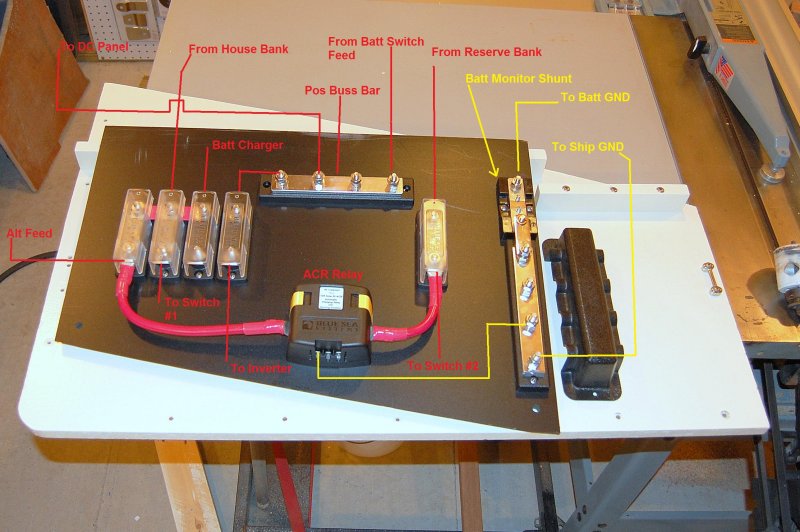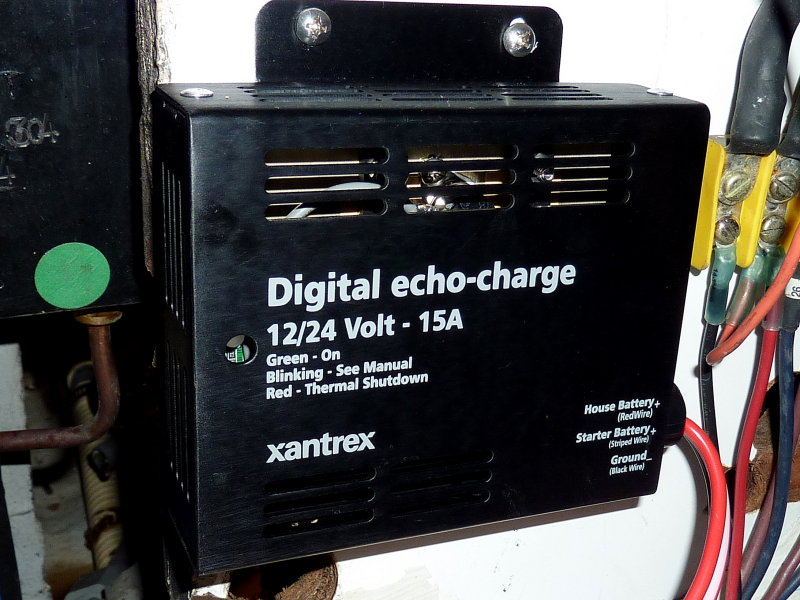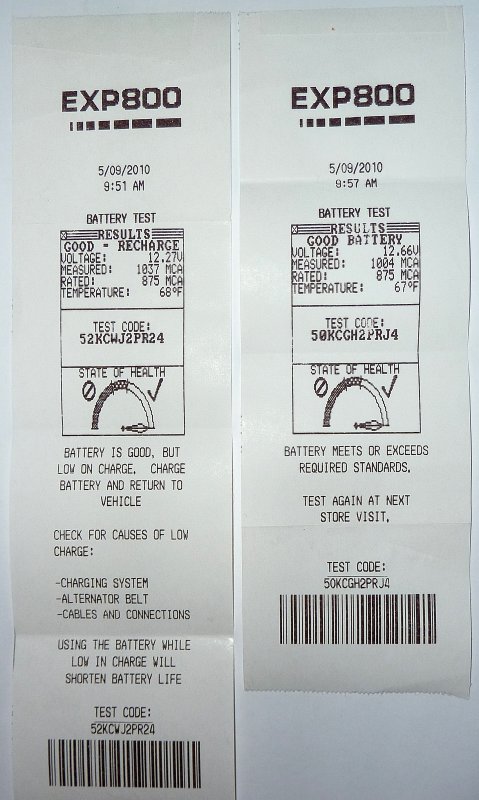After analyzing my electrical system, I've come to the realization that my batteries aren't wired the way they should be, or the way I want them.
The way it is........ I have a Perko battery selector switch with 3 terminals on the back. (#1-#2- Common) If my battery switch is on #1 the power for the starter and the house bank will draw off of the starter battery. If I switch it to both the starter and house draw off of both. If I switch it to #2 the starter and house draw off of the house bank. Shouldn't the batteries be wired up so that one powers the starter and the other powers the house. and if so, how would I wire that without buying another battery selector switch? Another question would be......How would I get both batteries to charge if they are separated? The battery selector switch isn't original, so I'm think the PO had all of the wiring wrong, but I can't seem to find the right way to wire it up. I've looked in Nigel Calder's and Don Casey's books but I can't seem to find a wiring diagram that lays it out this way. Am I wrong to want my batteries hooked up like this?
Dave
Dave,
It is perfectly fine the way it is. There is little to no need on a small sailboat with small aux diesel to need a dedicated "starting" battery. I have started all my engines, for a long, long time on my house banks. I use a 1/2/BOTH/OFF switch on my own boat and only ever use position #1 (house) and OFF. Position #2 (reserve bank) and BOTH are for an emergency only. I don't think in terms of a start and house I think in terms of a reserve and house.
The 1/2/BOTH/OFF switch is a very useful device and there are a few small changes that you can make that will make it even better. Please do keep the 1/2/BOTH/OFF. Everything you need for a very simple and redundant system is already there and there is no need to spend more money on new switches or drill yet more holes in your boat over what you already have.
Simply make your house bank #1, ,or "primary" and the start/emergency battery #2 or "back up/secondary". #2 as a secondary battery, for me, is always easy to remember but this is just a personal preference.
When you get to the boat simply switch to bank 1. When you leave the boat simply switch to OFF. You'll use the house batts for everything.. By doing this you'll only ever need to use position #1/House yet your emergency (start) bank will always be sufficiently charged if and when it is needed if you've also upgraded to an Echo or ACR type charging device. The charging of the start bank can all be done behind the scenes and is automatic by adding an ACR or Echo type charger. Doing this avoids the large "human error" factor of memory lapses.
What happens if I kill my house bank?
If you kill a bank don't fall into the trap of combining the dead bank with a perfectly good one by using the BOTH feature. Simply switch to the second fully charged reserve bank when you need to. Combining a good bank with a dead bank only bleeds off precious cranking amps from the good battery.
Can my house bank really start my engine?
YES!! If you are practicing good battery management and never discharging the house bank below 50% state of charge you should always be able to start your engine just fine using the house bank and will only ever use the battery switch when you get to the boat to flip it to position #1/House. When you leave turn it to OFF. I have three group 29/31 batteries on my vessel. Even though they are deep cycle they still produce a combined MCA (marine cranking amp) rating of well over 3000 amps at about 65 degrees F. My single group 31 reserve battery, in comparison, only has 1000 MCA.
It takes VERY LITTLE from your bank to start a small diesel. In fact I can not even measure .1 Ah of consumption from a 240 Ah bank, using a Xantrex Link Pro when I start my 44HP four cylinder diesel.
Starting the engine requires very, very little from a battery, many folks over think this and believe it requires a lot more than it really does. The peak in-rush current draw, for a split second, on my 44HP four cylinder Westerbeke is about 160 amps (peak split second current). The starter motor on my Westerbeke is a 1.5 kW an the starters on the average Universal M-25's are .8 kW.
The 1/2/ALL/OFF switch is a great device, if wired appropriately. When wired in the fashion most builders do, it sucks and thus gets a bad rap.
The 1/2/ALL/OFF switch retains all the original features & benefits yet looses the frying of diodes and the switching back and forth if you wire the alt direct to house and use an ACR, Echo type charger to top off the start bank.
For instance if your ACR or Echo Charger failed, which could happen, you can always use the ALL/BOTH feature to charge both banks from the alt just as you always did. No repairs or jumper wires just flip the switch to ALL, for charging, and you're back in business.. You will not however fry the alternator diodes because it always has a load on it by wiring directly to the house bank.
It is a good idea to add a fuse/breaker within 7" of the battery for the direct feed alt wire. It is also a good idea to fuse your banks.
As always there is no one right way to wire banks, unless you do it dangerously, but on small boats it makes little sense to ditch a perfectly good 1/2ALL/OFF when a simple re-wire will give you everything you need with simplicity and total redundancy should a combiner fail..
#1 Assign house bank to batt switch position #1
#2 Install reserve battery to position #2
#3 Wire alternator output directly to the house bank with sufficient size cable & fuse.
#4 Install ACR or Echo Charger between banks.
#5 Use boat in position #1 for starting AND house loads. Switch to OFF when you leave it's that simple.
So why do I want to wire my alt direct to the house bank??
I prefer to feed the alt directly to the house bank and not the reserve bank as the start bank is for back up or emergency, in this situation, and would usually be at or near 100% SOC anyway.
1- No more worries about fried diodes.
2- Accurate voltage sensing & less chance of voltage drop over factory wiring.
3- If you use an Echo Charger you need to do this anyway
You should NOT however wire the alt directly to the house battery unless you have either a VSR/ACR (voltage sensitive relay/ automatic charging relay) or a unit like the Echo Charger or Balmar Duo Charger.
Follow me on this one.
If you sense/wire directly to the house bank, bank 1, but do not have an ACR or Echo type unit installed, this means you could physically select the battery being used via the 1/2/BOTH/OFF switch.
If you select bank two as your source and the alt is connected to bank 1 you will draw down bank two and not replenish it unless the ALL function is selected during charging. In short, without an ACR or Echo type charger I would not wire directly to the house bank and instead would leave it wired through the common post of the battery switch.
With an ACR/Echo you can still select bank 2 but it will automatically be getting charged via the combiner or Echo even with the house bank being direct wired...
So what is a battery combiner / ACR / VSR??
Blue Sea ACR Si Series (LINK)
An ACR is an
automatic charging relay or as I like to describe it an
automated "BOTH" switch. All an ACR does is parallel or isolate the two banks based on voltage, hence the term VSR which just means "voltage sensing relay".
The term "ACR" is Blue Sea Systems trade name. A VSR is essentially a high current automated relay that senses voltage and combines banks when the voltage rises.
With the Blue Sea ACR if it senses 13.6 volts for more than 30 seconds it combines or parallels the banks. If it senses more than 13.0 volts for a period of two minutes, it also combines or parallels the banks.
When an Blue Sea ACR senses a drop in voltage below roughly 12.35V, for more than 10 seconds, it opens or disconnects. It will also open when it sense 12.75V or less for more than 30 seconds.
Combiners, VSR's, ACR's or what ever you prefer to call them, are very simple and fully automatic requiring no human intervention at the battery switch. Truly a
"set it and forget it" device..

VSR's, unlike antiquated diode isolators, can work with any charge source you desire. When voltage begins to rise, from solar, wind, alternator or shore charger the VSR/ACR's logic automatically energizes the relay coil, closes it, and combines/parallels the banks for charging. Electrically speaking this is no different than if you flipped the 1/2/BOTH/OFF to BOTH in order to charge both banks.
The best feature of a combiner is that it
never forgets to parallel when charging is present or isolate/disconnect the banks when a charge source is not present. When the batteries are not seeing a charge source they are fully isolated or disconnected from one another.
These devices are relatively inexpensive $65.00 - $150.00 depending upon model and amperage. They are also very easy to wire. The Blue Seas ACR has three wires to connect, ground and house and start bank jumpers. Yandina also makes a battery combiner/VSR.
If you wire a VSR properly, meaning all charge sources are wired to directly charge the house bank, then you can get away with a much smaller amperage VSR. The smallest Blue Sea ACR is rated at 65A and is plenty for charging a starting battery, if all charge source already feed to the house bank. The little Blue Sea m-Series 65A ACR runs about $59.00 and is a tremendous value.
The unit labeled ACR is a Blue Seas ACR:
So what is an Echo Charger or Battery to Battery Charger?
Xantrex Echo Charger (LINK)
The Xantrex Echo Charger belogs to a family fo charge management devices called DC to DC chargers or Battery to Battery chargers (B2B's). The Echo Charger is essentially an electronic 12v to 12v charger. B2B chargers like the Echo Charger do not technically combine/parallel the banks and are single direction chargers. The banks remain isolated and current can only pass from the house bank to the start bank. It simply takes or "bleeds" it's power from the charge source or the house bank and when it senses over 13.0 volts energizes and begins charging the reserve bank. When it sense below 13.0 volts it turns charging off. It can supply up to 15 amps of charge current to the reserve battery while borrowing/bleeding it from the house bank. Normally that battery will be at or near full and you'll rarely ever see it pull more than an amp or two anyway so 98% of the time your alts full output heads directly to the house bank. The Echo Charger is also a voltage follower and will follow the incoming voltage to the house bank. When the house goes into float mode so does the reserve bank.
The Echo Charger is also a simple three wire hook up but needs to feed the reserve bank, and pull from the house bank. All charge sources should be fed to the house bank, solar, alternator, wind and shore side charger.
This is an Echo Charger:
The Balmar Duo Charger is similar to the Echo, and a bit more expensive and can supply up to 30 amps of charge current.
By simply adding an ACR or Echo Charger, you can still go to your boat and select HOUSE and when you leave select OFF. That's it, simple. The charging of the start bank is taken care of
behind the scenes.
Voltage Brown-Out's:
Some folks complain of voltage drop out for electronics when starting off the house bank. I don't experienced this in any of my installations. I can start the engines and not reset any of the electronics even down to about 35-40% state of charge, in a properly sized & wired system.
If drop out is occurring then there are really only a few scenarios that cause this.
#1 Your batteries may be ready for replacement
#2 Your wiring is undersized
#3 Your system is wired incorrectly
#4 You have some bad connections.
#5 Your bank is simply too small
To avoid drop-outs you can start the motor, then flip on the instruments.
You can also choose to direct wire a dedicated starting battery but it will be more complicated if you want to retain the ability to start off the house bank in an emergency. This is why the 1/2/BOTH/OFF is such a good tool despite it often beingbadly maligned.
P.S. I edited the title so you hopefully get more responses...





